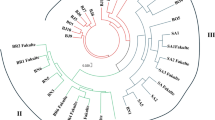Abstract
In order to determine genetic diversity ofOryza meyeriana (Zoll. et Mor. ex Steud.) Baill., 12 enzyme systems encoded by 17 loci were electrophoretically analyzed in 164 individuals of seven populations from Simao Prefecture, Yunnan Province, China. In comparison with those seed plants with the same life history and breeding systems, as well as the other species in the genusOryza, the species shows rather low levels of genetic diversity (A = 1.1,P = 8.0 %, Ho = 0.004 and He = 0.015) within populations and high genetic differentiation among populations. Fst was up to 0. 649, suggesting that 64. 9% of total genetic variability exists among populations. Considering high genetic differentiation among populations from a limited geographic region, most of the populations of the species are worth being protected, and therefore, great natural protection regions should theoretically be established in which a great deal of populations should be involved for developingin situ conservation management. Meanwhile, some priory localities forin situ conservation ofO. meyerzana in Yunnan Province, were proposed.
Similar content being viewed by others
References
Chang, T. T., Conservation of rice genetic resources: Luxury or necessity?Science, 1984, 224: 251.
Vaughan, D. A.,The Wild Relatives of Rice: A Genetic Resources Handbook, Los Banos: International Rice Research Institute, 1994.
Vaughan, D. A., Chang, T. T.,In situ conservation of rice genetic resources,Economic Botany, 1992, 46(4): 368.
Hong, D. Y., Recurring germplasm resources of wild rices in China,Bulletin of Chinese Academy of Sciences (in Chinese), 1995, 10(4): 325.
Gao, L. Z., Zhang, S. Z., Zhou, Y. et al., A survey of current endangered status of wild rice in China,Chinese Biodivrsity (in Chinese), 1996, 4(3): 160.
Ge, S., Hong, D. Y., Genetic diversity and its methodologies, inThe Principal and Methodologies of Biodiversity (ed. Committee of Biodiversity of Chinese Academy of Sciences) (in Chinese), Beijing: China Technological and Scientific Press, 1994, 132.
Hamrick, J. L., Godt, M. J., Allozyme diversity in plant species, inPlant Population Genetics, Breeding and Genetic Resources (eds. Brown, A.D.H., Clegg, M.T., Kahler, A.L. et al.), Sunderland: Sinauer, 1990, 43–63.
Soltis, D.E., Haufler, C. H., Darrow, D. C. et al. Starch gel electrophoresis of ferns: a compilation of grinding buffers, gel and electrode buffers, and staining schedules,Amer. Fern. J., 1983, 73: 9.
Glaszmann, J. C., de los Reyes, B. G., Khush, G. S., Electrophoretic variation of isozymes in plumules of rice (Oryza sativa L.): A key to the identification to 76 alleles at 24 loci,IRRI Research Paper Series, 1988, 134: 1.
Swofford, D. L., Selander, R. B., BIOSYS-1,release 1.7, Champaign: Illinois Natural History Survey, 1989.
Nei, M., Estimation of average heterozygosity and genetic distance from a small number of individuals,Genetics, 1978, 89: 583.
Wright, S., Evolution in Mendelian populations,Genetics, 1931, 16: 97.
Gottlieb, L. D., Conservation and duplication of isozymes in plants,Science, 1982, 216: 373.
Second, G., Origin of the genic diversity of cultivated (Oryza spp.): study of the polymorphism scored at 40 isozyme loci,Jpn J. Genet., 1982, 57: 25.
Barbier, P., Genetic variation and ecotypic differentiation in the wild rice speciesOryza rufipogon, Population differentiation in life-history traits and isozymic loci,Jpn, J. Genet., 1989, 64: 259.
Barbier, P., Genetic variation and ecotypic differentiation in the wild rice speciesOryxa rufïpogon, Influence of the mating system and life-history traits on the genetic structure of populations,Jpn. J. Genet., 1989, 64: 273.
Wright, S., Isolation by distance,Genetics, 1943, 28: 114.
Author information
Authors and Affiliations
Additional information
Project supported by the Grant of the President of the Chinese Academy of Sciences.
Rights and permissions
About this article
Cite this article
Gao, L., Ge, S., Hong, D. et al. A study on population genetic structure ofOryzu meyeriana (Zoll. et Mor. ex Steud.) Baill. from Yunnan and itsin situ conservation significance. Sci. China Ser. C.-Life Sci. 42, 102–108 (1999). https://doi.org/10.1007/BF02881755
Received:
Issue Date:
DOI: https://doi.org/10.1007/BF02881755




